Controlling aquarium algae in a saltwater tank can be so frustrating that it causes some people to shut down their tanks and quit the hobby completely. This article is intended to show you 23 relatively easy steps that can help you regain control of your tank.
When reviewing this list, just keep in mind that you will have the greatest chance at success by utilizing several tips at once and that not every tip on this list works for every type of algae. To successfully get problematic aquarium algae under control in your tank, you need to identify which species is causing the problem and match it up with the controls specific to that species.
Here are 23 quick tips for controlling aquarium algae in a saltwater tank:
1) Fight algae with algae
The aquarium-spin on the expression: fight fire with fire is to fight algae with algae. You can decrease the algae you don’t want, in your tank, by purposefully keeping algae in a sump, refugium, or algae scrubber. Algae growth is fueled by nutrients in the water–the nutrients are essentially fertilizer. When you fight algae with algae, the algae you want to keep (but don’t have to look at) take the nutrients away from the problem algae and tip the scales in your favor.

This technique should work for most algae unless your problem is being fueled by a specific nutrient not absorbed by the algae in your sump.
Learn more about 4 macroalgae species that can help you keep phosphates and nitrates down.
This tip is helpful to control Bryopsis, cyanobacteria, hair algae, bubble algae, and others.
2) Controlling aquarium algae: Increase ALK (if low)
Low alkalinity can be one of the factors contributing to your algae problem. That’s not the case in all problem situations, but making sure your ALK is where you want it to be for a reef (around 8.2), can help make it a little tougher for some of the problem algae. When you’re alkalinity is high, it actually ‘forces’ the phosphate levels to be lower by precipitating the phosphate out of the water (which essentially means it makes a phosphate pellet that is chemically unavailable for the algae).
One of the classic ways to raise the alkalinity of your aquarium water is to replace evaporation water with kalkwasser-saturated freshwater.

Learn how to dose kalkwasser here.
Learn more about the ideal reef tank water parameters here.
3) Get your hands wet and start pulling ‘weeds’
You’re not going to successfully be controlling aquarium algae without getting your hands wet. Well, technically, you should be wearing gloves. But actually reaching into your tank and removing the problems however you can–pulling, scraping, scrubbing. It all helps. The more you remove, the faster you’ll fix your problem.
It is important to know that yanking, pulling, popping and otherwise disturbing macroalgae can actually help it spread some in your tank–because, like your corals, most macroalgae are capable of reproducing from fragments. So you will see some websites or veterans recommend caution when disturbing the problem. Caution is good, but my advice is to weed your aquarium with vigor and conviction. Yes, you may get some spreading, but play to win and make it worth the effort.
4) Call on your guardian angelfish to help with controlling aquarium algae
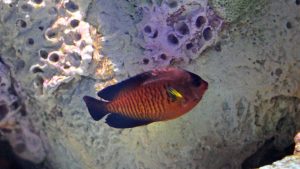
Dwarf angelfish species like the Flame Angelfish, Bicolor, and Coral Beauty are hungry little algae-eaters. They will also constantly nip at rock and glass surfaces, removing algal films and moving around detritus, which should help you on your quest.
5) Add some more corals to help with controlling aquarium algae
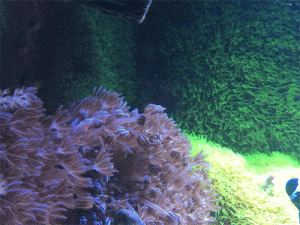
Let’s face it, we’re in this hobby because we love to look at our corals and fishes. Sometimes algae problems can happen because your tank doesn’t quite have the balance it needs to keep the algae in check. Adding another coral colony to your tank can help in a few ways – some species of coral absorb water from the water column and other species even ‘fight’ algae themselves, chemically. To be fair, I wouldn’t advise placing your hard-earned money or the coral’s life in imminent jeopardy, if you are losing your battle with the algae, but it could help tip the balance in your favor if you’re almost under control.
Adding green star polyps, pulsing xenia, and Kenya tree corals or other soft corals can help with controlling aquarium algae.
6) Increase water flow
Many of the problem algae species need sediment/detritus or other ‘trapped stuff’ to get a foothold. Also, pockets of detritus also cause decay and ultimately contribute unwanted algae fertilizer into the saltwater tank. A simple way to keep the algae on their ‘heels’ on the path towards controlling aquarium algae is to keep that water flow UP by using a bigger return pump or adding a powerhead or gyre pump.
7) Create a phosphate reaction
Sometimes the culprit is having too much phosphate in the aquarium water, causing the algae bloom. So a great way to get that algae under control is to add a phosphate reactor with a media that will chemically pull the phosphate out of the water.
GFO (granulated ferrous oxide) is a very popular aquarium reactor media to help remove phosphates from your aquarium water.
Check out these popular aquarium reactors.
8) Get crabby – hermit or Mithrax
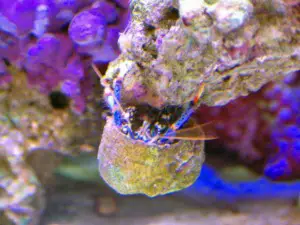
Hermit crabs and Emerald crabs will eat many species of problem algae. Just be careful, crabs are omnivores, not herbivores, and may snack on some other things in your tank, too.
9) Get dressed up (put on a tuxedo…urchin)
Urchins LOVE to eat algae. Lots of different kinds of algae. They can certainly help keep alga populations under control. There are two species of urchins that are fairly common in the aquarium hobby, Diadema (black long-spined) urchins and tuxedo urchins. They will eat your coralline algae, too. and love to knock things (coral plugs, live rock, etc.) over.
10) Stop being so salty (lower salinity)
If your algae problem is on a few pieces of live rock that you can get access to relatively easily, you can pull those pieces (one at a time or a few at a time) and place them in a separate holding tank. If you gradually lower the salinity by about 10% over a few hours, you may be able to kill off certain species of algae and keep some of the life on the live rock alive.
You could go a bit more extreme and nuke the entire live rock by going really low salt…too…which is a more drastic approach to the technique.
Whichever way you decide, just know that any significant salinity change may cause some of the more fragile creatures on your live rock to die (like sponges). Make sure you test your water to be sure your rocks are hemorrhaging ammonia from die off before you put them back in the tank.
Testing for salinity, or more accurately, specific gravity, is generally performed with a hydrometer or refractometer. If you haven’t replaced your hydrometer in a while, it’s a good thing to do so. If the swing-arm sticks, it can give you a false reading, which could cause more problems than you were hoping for.
Check out new hydrometers here.
11) Tang time

Certain tang species, like the Yellow Tang and Kole Tang, are natural consumers of algae and algal films (which are not something you would watch on Netflix). They will swim around the tank all day picking at the rocks and glass, nibbling bites of algae.
The only downsides with keeping a tang species in your tank are that they do require a lot of space to swim (~90+ gallons), and they won’t eat every type of algae. Tangs are best at eating hair algae, sea lettuce, algal films, and sometimes diatoms and bubble algae.
12) Throw the nutrients out with the bath (tank) water
Sometimes the problem with problem algae is excess nutrients in the water – ammonia, phosphate, nitrates. If you scale up your water changes, you’ll literally be throwing your problems down the drain.
13) Stop water changes
Wait…what? I know, I just told you that sometimes doing MORE water changes is the solution. But sometimes doing fewer water changes, or STOPPING, for a while, is the best solution–particularly if you think your source water (the clean stuff you put back into your tank) is part of the problem. Often times you can be adding phosphates or silicates or trace nutrients from your replacement water.
Also, in the situation of dealing with toxic dinoflagellates, you may actually want to seal up the problem until it runs its course (unfortunately).
So be sure you have a decent ID on what the problem algae are and a hypothesis on what the source problem is before scaling up or down your water changes.
14) Skim
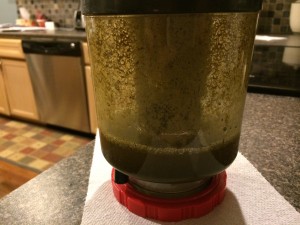
Protein skimmers are great at removing organics and some solid particles from the water. The gunk you pull out of your water with a protein skimmer is gunk that won’t fuel an algae outbreak.
Research the best protein skimmer brands here.
15) Scrub or slug
When controlling aquarium algae in a saltwater tank you will want to physically remove it from glass, live rocks, and coral. Don’t just pull it off the rocks. Get in there and scrub it, with a clean toothbrush and if you see a lot of floating algae particles, try to vacuum them up, as well.
16) Activated carbon
Adding some activated carbon for additional chemical filtration capacity can help remove chemicals from the water column that would otherwise fuel algae growth. Also, as aquarium water ages, it tends to take on a ‘yellowing’ color. The change in the water’s color then can degrade the quality of the light in your tank, which can then tip the balance in favor of the problem algae, fueling growth and selection of species that grow faster and better with that lower quality light.
17) Medicate (with great caution and as the last result) when controlling aquarium algae
Cyanobacteria and Bryopsis algae both can be fought through mediation (antibiotics for the first and antifungals for the second). It would be conspicuous to leave them out of this list of 23 ways to fight problem algae–and I do want to be transparent with you that they are an option. But I really do just recommend them as a last resort, as there are unintended consequences of jumping right to the medications and encourage you to seek (a lot) more information there.
18) Improve your source water
After digging in to figure out what is causing the algae outbreak, some people find out that the problem is with the water coming out of the tap. It is ‘normal’ for there to be silicates or phosphates, in some municipalities. So if things seem to be worse after your water changes…your efforts in controlling aquarium algae will improve if you can improve your source water before you mix in the salt with RO/DI system or start purchasing your water from a local fish store that purifies their own.
Check out popular RO/DI units online.
19) Lights out when controlling aquarium algae
For stubborn algae problems, it can often help to turn the lights out for a day or two, or three while you’re most actively fighting and removing it. None of your photosynthetic critters will love going without lights–but your corals will handle it better than the algae–and sometimes this is one of those factors that can tip the scales back in your favor while you eradicate the problem and then outcompete the algae.
20) Have a blast (to remove sediment)
While this tip probably won’t solve your algae problem completely, it can help, especially when paired up with a few of the other tips in this article. Your goal here is to take a powerhead and aim it at the low-flow areas of your tank, over corals, live rock, etc., and blast the sediment and detritus out. Those areas of detritus, sediment, and low flow are the spots that allow the algal growth to start.
21) Rabbits and Hares, oh my!

Some of the greediest algae eaters out there are rabbitfishes, like the Foxface. Eating algae is what they are here on this earth to do, which makes them a key ally in controlling aquarium algae.
Or, if you prefer invertebrates:
Certain sea hares are also put here on this earth to eat algae–which is a great quality when you’re trying to clear out algae problems. But make sure to weigh out the pros and cons, because these slugs can sometimes cause other problems. You can learn more about a popular sea hare here.
22) Blennies
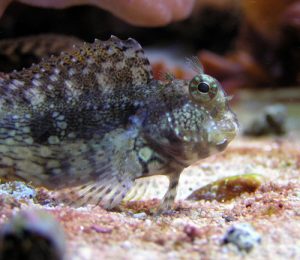
It won’t be hard to figure out which blennies are good with controlling algae in a saltwater tank…they have names like Algae or Lawnmower. The biggest concern with these species is usually that they will do such a good job of cleaning up the algae that they eat (they only eat certain types of algae) that they will starve to death afterward.
23) Clean up, at a snail’s pace…literally
A relatively inexpensive way to with controlling algae in a saltwater tank is to add some snails. Cerith, Turbo, and Trochus species are generally available AND are great at eating algae.

Looking for more tips?
If you’re looking for more tips to helpful advice, check out my book: 107 Tips for the Marine Reef Aquarium
You can read the e-Book free, as part of Kindle Unlimited, buy your own copy, or have the paperback book shipped to your door.
Conclusion and final notes
Please keep in mind that controlling aquarium algae outbreak in your saltwater tank is not something that you will be able to get under control with one simple step, but if you take some time to properly identify the problem algae species and the underlying problem fueling the growth of the algae, you can then find the 3, 4, or 5 small steps you can take to get the problem under control.
I used the metaphor of ‘tipping the scales’ a couple of times, in this article and encourage you to think of the solution of controlling aquarium algae in that way. Managing a saltwater aquarium is a balancing act–the presence of your problem algae suggests there is an imbalance. The key is to be persistent and make a few small changes to tip the balance in your favor. The aquarium wants to be balanced, you just sometimes have to give it a nudge.
If you enjoy what you’re reading here, you can also sign up for the FREE Saltwater Aquarium Blog Newsletter.
Can you add a tip to this list? If so, please leave a comment below to share your advice about controlling aquarium algae in a saltwater tank. Thank you!
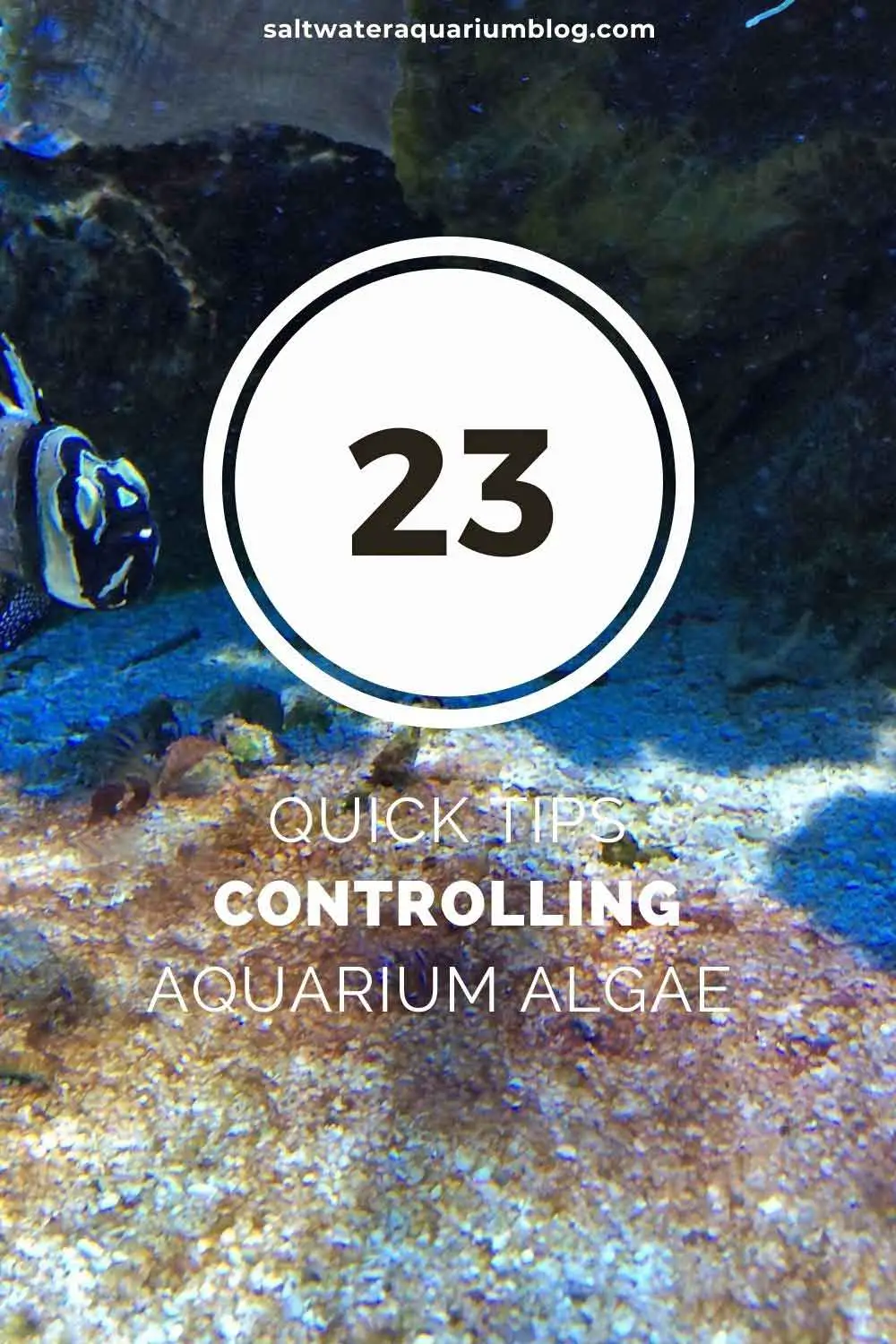








Leave a Reply